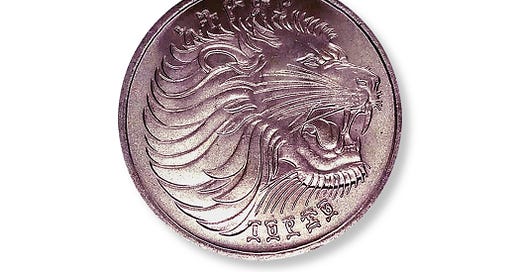This fellow looks like he means business.
It’s kinda sad when you realize most coins feature pictures of political leaders. Kings, queens, presidents, sheikhs and the like appear on the majority of coins worldwide. But what about the King of the Jungle?
Besides political figures, about 15 percent of coins show images of eagles, falcons, condors and similar majestic birds, and about 10 percent show pictures of lions. The fierce lion above appears on the obverse of 1977 Ethiopia 25 cents. Most Ethiopian coins feature lions.
If you go to our coinquest.com site and search for “lion,” you will get pictures, descriptions and values of 393 lion coins. We’ve selected a sample here for you.
Lydia - It takes some squinting, but if you ponder this Lion and Bull Stater from Lydia in ancient Greece (560BC to 546BC), you can make out the head of a lion on the left, mouth wide open, and the head of a bull, unimpressed, on the right.
The kingdom of Lydia is located in today's western Turkey. It has rich history in Greek and Roman cultures, including biblical history in the book of Revelation. From a numismatic (coin collecting) standpoint, many scholars agree that the Lydian Kingdom was the first to produce metallic coinage, starting in the 7th century BC.
Armenia - Jumping ahead 1700 years, this is a silver Double Tram from Armenia (1199AD to 1226). Lions, crosses, and fleurs de lis were popular symbols during the medieval Crusades. But King Levon could not resist putting his image on there!
Czechoslovakia - This is a Prague Groschen from medieval Czechoslovakia (1278 to 1564) with a rampant, double-tailed lion which appears in the coat of arms of Bohemia. Thanks to rich deposits of silver in Kutna Hora, Prague groschen became a substitute for still circulating dinars and brektty. These are silver coins which weigh near 4 grams and fineness about 0.930.
The Oxford dictionary defines rampant as “Heraldry: (of an animal) represented standing on one hind foot with its forefeet in the air with right hind foot and tail raised,”
Spain - One must not discuss lions on coins without mentioning “castles and lions” which are so prevalent on Spanish coinage. This is a Spanish 4 Reales of Philip IIII (1605 to 1665). The “castles and lions” appear on the reverse, with the king’s name “Philippvs IIII” on the obverse. Also, on the obverse you can see the denomination “IIII” and mintmaster “P” (see the catalogs for mintmaster P = Segovia mint, Esteban de Pedrera for coins dated between 1625 to 1630).
Denmark - Here is an old Danish 4 marck (1652 to 1661). These had the dual denomination of 1 'krone.' As any Dane would know, coins of this denomination are still in circulation, though they are no longer made of silver, and are much smaller nowadays. This example was struck under Frederik III of Denmark; note the F3 monogram.
Italy - The dvcatvs venetvs (ducat Venice, 1688 to 1694) means ducat from Venice and the fran mavroc means it is from the time of Francesco Morosini, who was Doge (a political leader) at the time. The lion on the reverse side represents Saint Mark, author of the second book of the New Testament.
Seppo, an interested reader, has supplied some details about this coin.
Hello! I can fill in some details. This is a silver ducat (ducato d'argento). In the inscription 'S.M.VEN.FRAN.MAVROC.D', the beginning 'S.M.VEN.' refers to 'Sanctus Marcus Venetiae' (St. Mark of Venice, the city's patron saint) who is shown on the left, passing the national banner to the Doge, depicted as the city's standard-bearer and kneeling before him. 'FRAN.MAVROC.D' indicates that the coin was minted during Francesco Morosini's reign as Doge, which was 1688-1694. The letters 'Z Q' are the initials of the superintendent of the Venetian mint, Zuane Querini, who was apparently superintendent of the mint only one year, 1689.
British India - The coin above is a genuine William one mohur dated 1835 sold by Ira and Larry Goldberg of Beverly Hills, USA for the astounding sum of $12500 US dollars during a 2013 auction. A two mohur coin, which looks the same, sold for $19500 the same year. You get the idea that this is a valuable coin.
Ethiopia - This is a medal, not a coin, commemorating Haile Selassie Coronation in 1930. Selassie was Ethiopia's regent from 1916 to 1930 and Emperor from 1930 to 1974. The medal was produced in silver for his coronation. The lion is impressive.
Burma (Myanmar) - 1 Pya (1952 to 1965) with a Chinze lion, or Chinese guardian lion, a mythical creature. Burma was part of the British Commonwealth until 1948, and the name was changed to Myanmar in 1989. Even though these coins are very exotic and very cool, there are more than enough to go around and fulfill collector demand. A few dollars buys a nice example.
Iran - The 100 dinars (1900 to 1911) above has exceptional eye appeal. The date appears below the lion in eastern Arabic numerals. It reads 1318. This is an Islamic (Hijri) date which corresponds to 1900 Gregorian.













